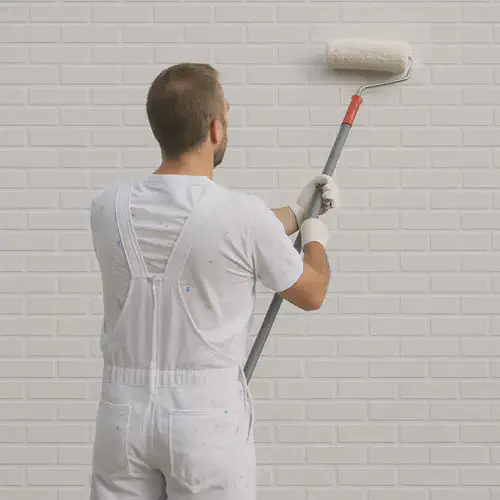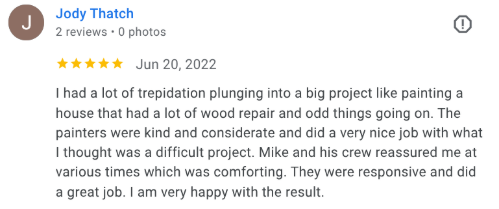Backrolling in the wrong situation can introduce more problems than it solves. Done poorly, the finish can end up blotchy and uneven.

What Is Backrolling and Why Is It Used?
Backrolling follows spraying with a roller to smoodge the paint into all the nooks and crannies.
It involves a second painter immediately rolling over still-wet paint—ideally before it begins to dry. The idea is to ensure contact with uneven surfaces and to spread paint more thoroughly into textured areas.
The best results come from understanding when to use a technique—not using it just because it fits a pitch.
While it might sound like a surefire way to improve coverage, it’s a niche technique—not a one-size-fits-all solution.
Spray-Only Produces a Consistent Paint Film
A consistent paint finish depends more on the person spraying than the equipment being used.
Today’s airless sprayers are capable of applying paint in a smooth, even coat—but only when used by experienced hands. With the right prep, setup, and operator, spraying creates a beautifully uniform paint film across every inch of the house.
That consistency matters. A clean, continuous film acts like shrink wrap for your home—providing long-term protection and a clean, professional appearance.
What Backrolling Is Supposed to Do
It’s meant to improve adhesion on certain substrates and to even out coverage—when conditions are right.
On porous surfaces like bare stucco, backrolling can help saturate the material and improve adhesion. In those niche cases, it makes sense.
But on most residential or small commercial projects—where the siding is already painted and relatively smooth—those benefits just aren’t there. In fact, backrolling in the wrong situation can introduce more problems than it solves.
Timing Matters More Than Technique
Paint begins to dry fast—especially in summer heat—making backrolling difficult to do correctly.
Paint begins to skin over within minutes. On a breezy day in Kansas City, that window is even shorter. If the person assigned to backroll isn’t close behind, the finish may end up blotchy and uneven.
And timing is rarely ideal. Backrolling often falls to the least experienced crew member—who’s also moving ladders, cords, or drop cloths between walls. It’s not just hard to execute—it’s almost impossible to do well, consistently.
On a breezy Kansas City summer day the paint can easily “skin over” before it is backrolled—especially if the person rolling is busy moving ladders or drop cloths.
Spray Application Delivers Uniform Coverage
When applied by a skilled painter, spraying creates an even film that’s smooth and uniform from top to bottom.
We’re focused on achieving the cleanest, most consistent paint layer possible—without the complications of mismatched textures or rushed rolling. Backrolling might sound desirable, but more often it’s undoing a good thing.
Some Surfaces Don’t Need Backrolling at All
Backrolling can disrupt the uniformity of a spray finish—especially on already-painted siding.
If a home already has multiple coats of paint, applying more with a roller adds unnecessary texture and may create sheen inconsistencies. Instead of improving coverage, it can cause certain areas to stand out.
That’s the opposite of what homeowners want: consistent color, clean edges, and a uniform appearance from every angle.
When “More Steps” Become a Sales Tool
Extra steps like backrolling or full priming can sound impressive—but that doesn’t mean they’re good practice.
Some contractors use backrolling to make their proposal sound more thorough. It’s framed as going the extra mile—but unless the surface truly calls for it, it’s just creating potential problems while adding time and cost.
Same goes for “we prime everything.” On repaint jobs, full priming can interfere with adhesion, create unnecessary buildup, or add a layer that doesn’t bond well with what’s underneath. We prime where it’s needed—bare wood, repairs, trouble spots—not because it sounds nice on paper.
How We Approach Backrolling—or Don’t
With over 1,000 exterior projects under our belt and many years of experience, we deliver lasting value—no matter how attractive poor practices might sound.
We know our products, we know Kansas City homes, and we know when a technique will help—or when it’ll cause trouble. Backrolling might be the right call in a very specific scenario, but for most homes and offices in Kansas City, clean and consistent wins the day.
You can also explore our take on best front door colors, see how we deal with wood rot, or learn why choosing colors can be daunting—but doesn’t have to be.
Book a Quick Estimate
Wondering what approach makes sense for your home? You can book an estimate online in just a few clicks. Most consultations take less than 30 minutes and give you clear, helpful information with zero pressure.



